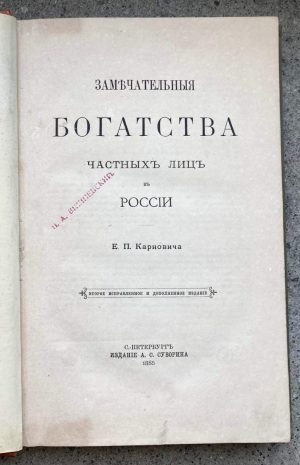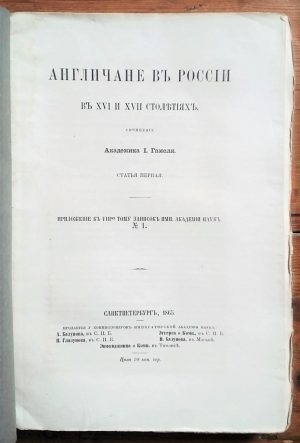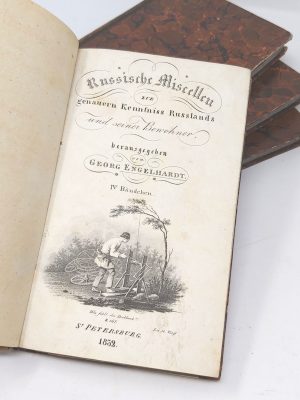Our Notes & References
A fascinating and very rare Russian letter-writing manual, containing more than 400 models of letters, including some in verses and many authentic ones translated from English and French, such as Catherine the Great’s letters to Voltaire, Queen Elizabeth to Admiral Charles Howard and Lord Nelson to his wife.
With extensive practical indications for administrative correspondence and paperwork.
After a 30 pp.-long table of contents, the three parts of this thick volume give extensive general recommendations followed by many letters aiming at covering most, if not all life events, with a focus on administrative and business dealings towards the end. It includes curious examples on various subjects, from denunciatory letters to a love affair break-up, letters reprimanding a friend for not answering, advice on how to write to a person whom you have insulted or how to thank your parents for the money they sent you. Some of the letters are unusually specific, such as the “letter to a friend about fashionable but old Persian women”, a note from a foreigner excusing himself for his silence and little knowledge of Russian, and a letter from a friend recommending to choose a not beautiful woman to marry.
Such manuals of correspondence appeared in Russia in the 18th century, inspired in particular by their French counterparts. It is only in the early years of the 19th century however that they began to include some authentic letters of Russian and foreign tsars, diplomats and prominent people, and this volume includes examples by Catherine the Great, Pavel I, Count Suvorov, the King of Prussia Frederick II, Queen Elizabeth, Lord Nelson, PA. Pope, Voltaire etc. It is worth noticing that such letters have been chosen not only for their style, but also for their content. For instance, in her letter of November 6, 1790 to Charles-Joseph de Ligne, Catherine briefly reviews the state of affairs of her ‘neighbours’: “Beijing newspapers say that my neighbour, the Chinese man, […] follows the innumerable rites of his land with astonishing accuracy. As for my Persian neighbours, they slaughter each other regularly every month […] The Poles are ready to undergo their unlimited military despotism to increase their freedom […] meanwhile we beat them and will always keep doing that out of the old habit, on land and at sea […] England arms herself without war, while Spain actually fights. The King of Prussia wants the dictatorship his uncle didn’t see in 1762. France has 1200 legislators whom no one but the king obeys…” She also confesses: “My treasury is in a bad state, for I have fought two wars without resorting to any new tax, because of the impossibility of doing so or ignorance” (our translation).
Exchanging laudative letters with Voltaire, Catherine discusses trade with China, legends about the Russian officers’ glory during the Russo-Turkish war of 1768-74 and Russia’s role as a defender of Christians in this conflict. Frederick the Great’s letter to Voltaire seems much less political and personal: the king expresses his admiration of Mérope and sends the philosopher a ring as a sign of his devotion. Queen Elizabeth is presented in her letter to Admiral Charles Howard praising his achievements in the victory over the Spanish.
This Pismovnik also clearly shows how such manuals extended letter writing to business life, and went on giving actual data necessary for all sorts of administrative activity. For Zharikova, their “most important role [was] to consolidate and disseminate certain forms of document unification, which led to a simplification of the bureaucratic processes”. Indeed, the second part here would be very useful to write different requests, complaints, petitions, work contracts, letters-statements for boys becoming apprentices to different masters, marriage and birth certificates, wills, announcements and bills – the last ones are even presented with a chart of interest fees. The reader also get advice on how to conduct commercial correspondence, and a business vocabulary with examples of various Russian regional merchants’ letters.
The third and last part goes beyond letter writing, and includes a Russian traveller guide [dorozhnik] with new postal rates across the Empire, and a detailed table of all the world’s coins in conversion to the Russian currency.
These last two parts show how the adaptation of Western models was much more than a mere translation of these manuals of correspondence: many letters here and most administrative writings are adapted to Russia’s specificity. A few letters, mostly related to love issues, are even written in verses, making them an interesting example of Russian poetry at the dawn of its Golden Age.
This 1820 “new edition” appears actually to be a resale of the sheets of an edition printed 10 years earlier. Only the first title was updated, nothing else, not even the title of the third part, still dated 1809, nor the postal schedules and such similar data, nor -paradoxically- a letter from the new Emperor (but, in 1820, defeated, exiled and ill) Napoleon Bonaparte to King George III about war and peace negotiations, originally published before Napoleon’s invasion of Russia in 1812.
Mostly anonymous, letter-writing manuals became popular in Russia in the second half of the 18th century, extending later to authentic letters and administrative dealings. Serving the needs of the growing middle class and petite bourgeoisie, various editions came to light, in Moscow, in St.Petersburg, by large and by small publishers, borrowing various innovations from each other, to become in the early 19th century multifunctional and engaging instruction books for a wide range of occasions. The St. Petersburg Cadets Corps, recently renamed by Pavel I, printed its own in 1807 in two parts, and added the third part for a new expanded edition in 1809-10, offered here with the 1820 new general title.
Both issues are extremely rare: KVK and Worldcat don’t show any copy of any of them, and we couldn’t find any example at auction outside Russia. We could trace however a copy of the 1809-10 edition in The Hague, as well as in the Moscow RGB, one example of this 1820 reissue, in Nizhnii-Novgorod, and one of each in the RNB in St. Petersburg.
Bibliography
Cf. Sopikov 8253 for the 1809-10 edition. Joukovskaïa A., “La naissance de l’épistolographie normative en Russie”, Cahiers du monde russe, 40/4, 1999; Zharikova S. Pismovniki i ikh primenenie v deloproizvodstve, Tambovskii gos. Universitet, 2019.
Physical Description
Three parts in a thick 8vo volume (21 ×10.7 cm). Mostly printed on light blue paper. Title, 32 t.o.c., LVII, 710 (but 609), and 119 pp. incl. title of part 3 (dated 1809) and section titles, with a folding letterpress table in part 2 (p. 560).
Binding
Contemporary Russian half calf over marbled boards, flat spine with red label lettered in Cyrillics, many leaves with lower margin uncut.
Condition
Rebacked preserving most of the cracked spine, extremities rubbed; some light foxing, occasionally heavier, a leaf with paper flaw minimally affecting the text; a pleasant example.

























![Image for Karafuto Shashin-cho [A Photographic Album of South Sakhalin], 1936. #2](https://www.pyrarebooks.com/wp-content/uploads/2023/03/2303_1-300x225.jpg)
